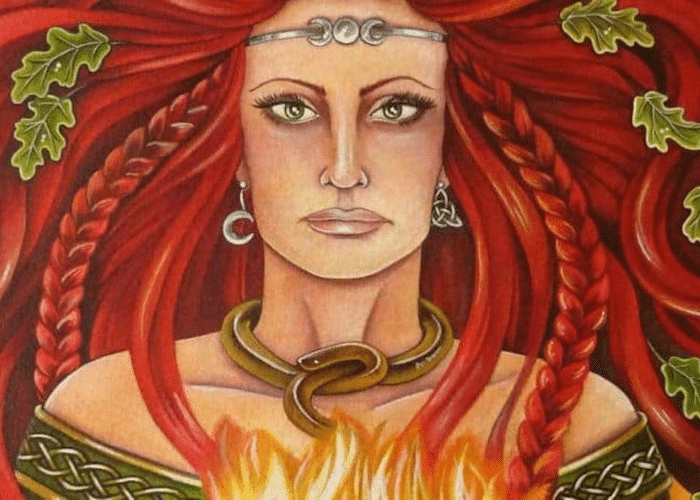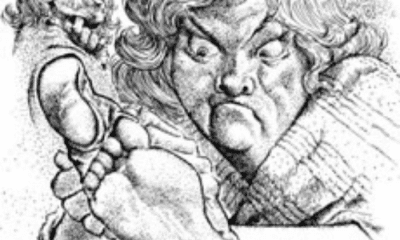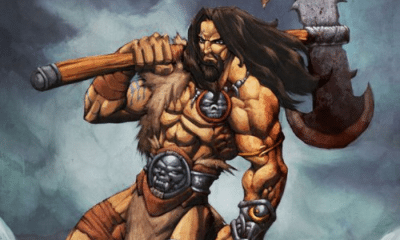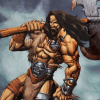
Irish
Brigid: The Beloved Goddess of the Celts
Brigid: The Beloved Goddess of the Celts
Among the many pre-Christian gods and goddess of Ireland, one was invoked more often and more fervently than any other. Keep reading to find out why Brigid was so well-loved in Ireland that she remains important around the world!
Brigid, or Brid, was one of the foremost deities of the Irish Celtic pantheon. Among the Tuatha De Dannan, she was one of the most popular goddesses.
Historians believe that Brigid was a largely personal goddess. People around Ireland found different ways to worship her for many different reasons.
She was the goddess of spring, the dawn, and fertility. She protected mothers and children, in part because she was unable to protect her own son.
She was an agricultural goddess who watched over cattle and sheep. She inspired smiths and other craftsmen.
The goddess of music was also called the most well-loved by the poets. Inspiring their songs made her the goddess of knowledge as well.
Brigid was so well-loved for so many reasons that she was one of the few pagan figures to not be lost when Christianity became the religion of the land. As a Catholic saint, she inspired veneration well beyond the shores of Ireland.
From a protective goddess to a patron saint, Brigid is one of the most enduring and influential figures in Celtic mythology!
The Many Brigids
In Ireland, Brigid had many domains.
She was worshiped throughout the Celtic world, although her legends are best known from Ireland. There and in Scotland, she is most well-known as the goddess of spring, but the various myths and artifacts that survive show that she had many other meanings as well.
Brigid was the patroness of agriculture, specifically farm animals. In this aspect, she was also sometimes considered to be a goddess of motherhood and birth.
Brigid was sometimes revered as a fire goddess. This often linked to her role as the goddess of smiths and metalworking.
Seemingly in contrast to this, she was also referred to as a goddess connected to wells and rivers. One of the most famous landmarks in Ireland, Brigid’s Well in Kildare, still bears her name.
The water from this well is also said to have healing properties. Brigid was revered as a healer, both through her wells and through other means, but was also known as a fighter at times.
Finally, she was thought of by many as a goddess of music and other art forms. She was thought to inspire songs, poetry, craftsmanship, and wisdom.
The many forms Brigid takes in Irish legends have led some to identify her as a possible triple goddess.
The idea of the triple goddess is well-known in Celtic and Irish lore. The most famous example from Ireland is probably the Morrigan, who can appear as either a single goddess or as three individuals.
Some legends claim that Brigid was the goddess of spring but that she also had two sisters, one a smith and one a healer. Adding to the likelihood that they would be mistaken for one another, all three were named Brigid.
Generally, Irish legends treat Brigid as a single goddess, although she may have had three aspects. Further evidence for this is in the fact that Brigid is not always depicted as the same age, taken on the appearance of either a young maiden or a wise mother.
As the goddess of so many domains, she was one of the most well-loved and widely-worshipped goddesses in the Celtic world.
The Goddess of Spring
Brigid is most commonly named as the goddess of spring and new life.
In this, she was the deity of fair weather, fertility, and the dawn. All three represented light, life, and a new beginning.
Some scholars believe that Brigid may have evolved from multiple goddesses and incorporated several archetypes. For this reason, she is linked to Indo-European archetypes of both fertility and dawn goddesses.
Her name distinctly links her to the idea of the dawn. Brigid has the same root as the English word “bright,” and originally meant “Rising” or “High.”
Brigid wore a robe of sunlight and had flame red hair, furthering her connection to the sun and its light. The connection ultimately made her the goddess of the time when the sun was at its brightest.
Brigid is often referred to as a spring goddess, although she could have dominion over any time when the weather was fair and the sun was shining. In Scottish folklore, for example, Brigid ruled over the world through the summer months until the Queen of Winter chased her back to Tir Na Nog.
The beginning of spring was marked in the Celtic world not by a specific date, but by when the worst cold of winter began to break. Thus, Brigid’s holy day in Ireland is often said to have been on February 1st, but in other parts of the Celtic world occurred as last as April or May.
Roughly halfway between the winter and summer solstices, Imbolc was the festival that celebrated the return of light and fertility to the world. Brigid came back to the Earth and, according to some traditions, visited the people of Ireland to give them blessings.
Unfortunately, contemporary accounts of Imbolc are rare and surviving folk tradition is heavily influenced by later Christian belief. Historians believe, however, that one tradition of Imbolc involved taking offerings of food or valuables to wells to earn Brigid’s blessings.
Some legends suggest that Imbolc may have been the precursor of the American tradition of groundhog’s day. In Irish writings it was a snake, rather than a groundhog, that would emerge from its hole even if there was still snow on the ground, to foretell the weather for the rest of spring.
Wells were also visited at Beltane, or May Day, which celebrated the summer solstice. This indicates that Brigid may have been worshipped then, as well.
Brigid’s association with fair weather and the holidays of spring and summer were not only tied to her dominion over the sun. They also had a good deal to do with farming, fertility, and the cycles of the Earth.
Brigid in Mourning
One of the cycles Brigid was associated with was that of life and death.
Although she was primarily a fertility goddess, Brigid’s stories also included loss. One of the most famous surviving legends of Ireland shows how the goddess of light influenced rituals of death.
The Cath Maig Tuired recounts the legends of how the Tuatha De Dannan, the group of beings Brigid belonged to, came to rule over Ireland. In two massive battles, they defeated previous ruling races, the Fir Bolg and the Fomorians, to win control over the island.
Brigid did not fight against the Fomorians in the Second Battle of Moyturra, but many members of her family did. Both her father, the Dagda, and her son were killed in the fighting.
According to the Cath Maid Tuired, Brigid’s son Ruadan had sided with his father, Bres. This put him on the side of the Fomorians and pitted him against his mother’s people.
Thus, Brigid’s loyalties were divided during the battle. When she saw her son fighting the smith god Giobhniu, she did not want either of them to fall.
Sadly, both did. Giobnui was killed first, but Ruadan was gravely wounded and fell soon after.
When Brigid saw her son die, she rushed onto the battlefield. She held him and cried, and her mourning could be heard for miles.
Brig came and keened for her son. At first she shrieked, in the end she wept. Then for the first time weeping and shrieking were heard in Ireland.
-Cath Maig Tuired
Brigid’s mournful cries were the origins of the Irish tradition of keening, the intense and almost musical wailing that was typically performed by women at funerals and wakes. While the tradition of keening at a death is not as strong as it once was, Irish musicians still use the style to this day.
The music of mourning was not the only artform Brigid was closely tied to.
While mourners looked to her for inspiration, other musicians did as well. They hoped to capture the same purity and emotion in their songs that the keeners did in grief.
In the same passage of the Cath Maig Tuired that describes her keening, Brigid is said to have also invented a whistle to use for night travel. This was one of the earliest instruments of the Tuatha De Dannan and, although it was originally a practical tool, it evolved into a source of entertainment.
Music was also a way to transmit knowledge. Like many cultures, the Irish set their poetry to music. History and legends were passed on through performance.
Beginning with her act of mourning, Brigid became a goddess of music and knowledge. Poets were said to love her more dearly than any other god and looked to her for inspiration.
The Patroness of the Farm
Despite her invention of keening, however, Brigid was not a goddess of death. That realm was more associated with the Morrigan, who was in many ways her opposite.
Instead, her link to the sun and spring made her a goddess of agriculture. In particular, she was the protectress of animals.
Because she had lost her own son, Brigid was said to carefully watch over mothers and their children. This included not only human women and infants, but also animals.
Cattle and sheep were both important to daily life in Ireland. Both provided milk and meat, while sheep gave wool and cattle produced leather and helped with plowing.
Cattle in particular were used as a measure of wealth and power. Many of the Ulster Cycle myths feature kings and queens raiding one another’s herds and arguing over ownership of prized animals.
Herdsmen would pray to Brigid to keep watch over their animals. The goddess not only made them fertile, increasing the owner’s wealth, but also looked after and protected them.
Brigid’s importance in agriculture can be seen in the festivals that celebrated her. Imbolc and Beltane were not only based on the cycles of the sun, but also on the farming season.
Imbolc, in early spring, marked the beginning of the lambing season for shepherds. Lambs born in February and March were particularly vulnerable to cold, so the maternal sping goddess’s sunlight was needed to keep them healthy.
Beltane was equally important for those who kept cattle, since early May was generally when herds would be put out to pasture for the summer. Brigid was thought to keep them safe then and encourage the safe delivery of calves.
Brigid was so important to the keeping of livestock that she was said to have many animals of her own. These included:
- Fe and Men – Her two oxen were said, like their owner, to be of “radiant beauty.” They grazed on a plain named after them, the Mag Femen, in County Kildare.
- Cirb – Brigid’s powerful ram was called the “King of Sheep.”
- Torc Triath – The goddess also owned a powerful boar. He survived in Arthurian legend as Twrch, a prince cursed into the form of a wild boar who is eventually hunted down by the king and his men.
In the Celtic religion, the gods were not entirely immortal. When one died, another took their place. For example, Brigid became the goddess of smiths after Giobhnui was killed in battle.
Brigid was often said to be the daughter of Danu, the mother goddess for whom the Tuatha De Dannan were named. In some ways, she seemed to have taken her mother’s place as the principal mother of the pantheon.
Little is known of Danu, but she is generally believed to have been an ancient member of the Mother Earth archetype. Many scholars believe she shared her name with the Danube River, where early Celtic culture originated.
By the time of the Irish myths, Danu was no longer an active figure. Her daughter Brigid took on her role as a protective mother figure associated with the earth.
While Brigid did not have as many children as many other mother goddess types, she was said to take special care of the young. Like most other earth mothers, she was also linked to the primary agricultural activities of her area.
Rockey terrain, poor soil, and a harsh climate meant that much of Ireland and Scotland were not ideal for growing grains and vegetables. The land was valued for its ability to support grazing livestock more than its own bounty.
While the people of Ireland and Scotland grew produce to support themselves, their land meant that grain would never be as important to them as meat. Their agricultural goddess reflected this.
Saint Brigid
The Tuatha De Dannan faded from importance after Christianity was brought to Celtic lands. In Ireland and elsewhere, they survived in folklore as the fae but were no longer seen as divine.
Brigid, however, was an exception to this.
While the other gods of pre-Christian Ireland faded from memory or were reimagined as less powerful spirits, Brigid’s cult was not so easily erased. She held sway over so many aspects of Irish life that the early monks found it impossible to completely erase her from folk belief.
Instead, they embraced the spring goddess. She became Saint Brigid and her story was rewritten for the Christian world.
The patron saint of Ireland shares many of the pagan goddess’s domains. She is said to watch over babies, mothers, and cattle.
Historians believe that St. Brigid of Kildare was a historical figure who, like many other women in Irish history, was named after the area’s most important goddess. The continued belief in the goddess Brigid, however, resulted in many of her attributes being given to the human figure to refocus worship into an acceptable Christian form.
St. Brigid was said to have been a nun in the 5th century. She founded a monastery and convent at Kildare, on the site of a shrine to the former pagan goddess.
Like the placement of the shrine, many legends of St. Brigid’s deeds tied to her the pagan goddess. She was said, for example, to have founded a school of art at Kildare where she encouraged metalworkers.
The veneration of Brigid as a Christian saint allowed the people of Ireland to continue invoking her as they had for centuries. While the prayers still called on the same name for the same reasons, they were now acceptably Christian.
Even the day on which she was celebrated did not change. St. Brigid’s feast day is still on February 1st and it was popular in some areas of Ireland to leave food offerings for her as late as the 18th century.
The patron saint of Ireland continues to be one of the Catholic Church’s most popular saints. To this day her name and its variants, such as Bree, Bridie, Bridget, and Brigitte, are popular in Ireland and elsewhere.
Ireland, of course, was not the only Celtic culture that venerated a similar goddess. In other countries, the Catholic saint replaced the Germanic goddess the Romans had named Brigantia.
The popularity of similar figures throughout Europe meant that St. Brigid’s influence spread far beyond Ireland. She became an important saint in France, Scandinavia, Germany, and elsewhere.
The Bride of Samedi
St. Brigid was so influential that she even carried over into other religions.
One of the more unlikely places that Brigid is venerated is in Haiti.
Vodou is a religion that developed in the Caribbean, primarily in Haiti, from the 16th to 19th centuries. Slaves from many African cultures combined their own beliefs with those of the French Catholics who ruled the island.
The loa, or spirits, invoked in Vodou are based on African gods but incorporate much of the symbolism and lore of the saints. The most well-known loa is Baron Samedi, the spirit of death.
Baron Samedi’s wife is Maman Brigitte. The bride of death in Haitian Vodou is directly inspired by St. Brigid and, in turn, by the Celtic goddess.
Maman Brigitte is associated with fire, based largely on Brigid’s traditional link to the sun and metalworking. She drinks rum infused with red chilis to make her breath as hot as a flame.
Although Maman Brigitte is a loa of the dead, she is still viewed as a protective, maternalistic spirit.
It is said that Maman Brigitte cares for the dead more than they were ever cared for in life. She takes pity on lost souls and helps to guide them safely into the afterlife so they can join her family.
Maman Brigitte also helps the living. Those who respect the dead and remember them earn Maman Brigitte’s thanks in life.
The figure of Maman Brigitte shows the same maternal care as the Irish goddess Brigid, but was formed under much harsher circumstances. To the slaves who worked on Haiti’s brutal sugar plantations, she represented the hope that they would find more love and peace after death than they did in life.
While the other loa of Vodoun were inspired by African deities, most scholars believe that Maman Brigitte is the only one to have come entirely from Catholic traditions.
While Baron Samedi and the other loa have African features, Maman Brigitte has the pale skin and bright red hair that mark her out as a goddess with Irish origins. Brigid was such a popular figure of protection, motherhood, and care that she can be recognized even in the beliefs of the African diaspora.
The Enduring Legacy of Brigid
In the mythology of Ireland and other Celtic cultures, Brigid was one of the most important deities. The Irish in particular saw her as a mother goddess, protector, and creator.
She was the goddess of the spring and the dawn. She represented new life, fair weather, and growth.
This did not, however, necessarily meant plant growth as it did in many other cultures. The Irish saw Brigid as a protector of domesticated animals more than as a goddess of grains or vegetables.
As a mother goddess, Brigid protected both human children and the animals she was associated with. Brigid granted fertility and offered protection to both human women and their babies and the animals they herded.
In mythology, Brigid’s protection of children grew from her inability to protect her own son. When Ruanan fought against the Tuatha De Dannan and was killed, Brigid’s cries became the first mourning song of Ireland.
The was one of many links to music, poetry, and emotion that made her a patroness of the arts. As the goddess of poets, she also enabled the transmission of knowledge and wisdom.
Brigid held such an important place in Irish culture that her cult did not entirely die out with the arrival of Christianity. She was synchronized with a Catholic saint of the same name, allowing people to still call on her and celebrate her feasts without offending the Church.
As St. Brigid, she is the patroness of Ireland. Said to have lived in the 5th century, she remains one of the most popular Catholic saints throughout Europe.
Her popularity extended beyond the European tradition. As the inspiration for Maman Brigitte, she is the only figure in Haitian Vodou to have an origin entirely outside of Africa.







